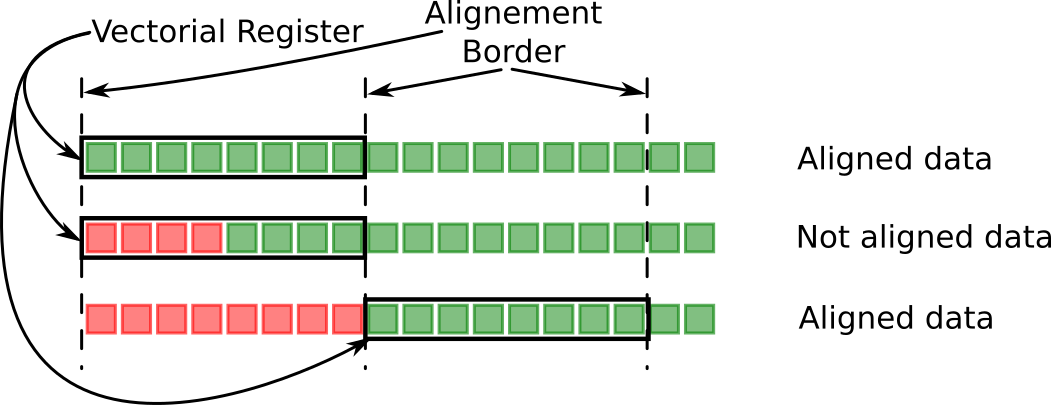6.6.2.1 : Things to verify before vectorizing
Data Contiguousness
The CPU has to read several elements at the same time.
Data contiguousness :
- All the data to be used have to be adjacent with the others.
- Always the case with pointers but be careful with your applications.
Data Alignement
Data alignement :
- All the data to be aligned on vectorial registers size.
- Change new or malloc to memalign or posix memalign
Let's do an other file (
main_vecrization.cpp) to be able to compare its performances with the previous version.
First, we have to include the appropriate files :
1
2
3
4
|
#include <iostream>
#include "asterics_hpc.h"
using namespace std;
|
The __restrict__ keyword
Specify to the compiler there is no overhead between pointers. Otherwise, its will not vectorize your code.
The
hadamard_product becomes :
1
2
3
|
void hadamard_product(float* __restrict__ ptabResult, const float* __restrict__ ptabX, const float* __restrict__ ptabY, long unsigned int nbElement){
}
|
The __builtin_assume_aligned function
Specify to the compiler pointers are aligned
If this is not true, you will get a Segmentation Fault
The
hadamard_product becomes :
1
2
3
4
5
6
7
8
9
|
void hadamard_product(float* __restrict__ ptabResult, const float* __restrict__ ptabX, const float* __restrict__ ptabY, long unsigned int nbElement){
const float* tabX = (const float*)__builtin_assume_aligned(ptabX, VECTOR_ALIGNEMENT);
const float* tabY = (const float*)__builtin_assume_aligned(ptabY, VECTOR_ALIGNEMENT);
float* tabResult = (float*)__builtin_assume_aligned(ptabResult, VECTOR_ALIGNEMENT);
for(long unsigned int i(0lu); i < nbElement; ++i){
tabResult[i] = tabX[i]*tabY[i];
}
}
|
We have to define the
VECTOR_ALIGNEMENT macro. Let's modify the
ExampleOptimisation/CMakeLists.txt file :
1
2
3
4
5
6
7
8
9
10
11
12
|
project(HPC_ASTERICS)
cmake_minimum_required(VERSION 3.0)
add_subdirectory(Performances)
include(runExample.cmake)
set(VECTOR_ALIGNEMENT 32)
add_definitions(-DVECTOR_ALIGNEMENT=${VECTOR_ALIGNEMENT})
add_subdirectory(AstericsHPC)
include_directories(${CMAKE_CURRENT_SOURCE_DIR}/AstericsHPC)
add_subdirectory(1-HadamardProduct)
|
The test function
We have to modify the test function to have aligned pointers :
1
2
3
4
5
6
7
8
9
10
11
12
13
14
15
16
17
18
19
20
21
22
23
|
void evaluateHadamardProduct(long unsigned int nbElement, long unsigned int nbRepetition){
float * tabResult = (float*)asterics_malloc(sizeof(float)*nbElement);
float * tabX = (float*)asterics_malloc(sizeof(float)*nbElement);
float * tabY = (float*)asterics_malloc(sizeof(float)*nbElement);
for(long unsigned int i(0lu); i < nbElement; ++i){
tabX[i] = (float)(i*32lu%17lu);
tabY[i] = (float)(i*57lu%31lu);
}
long unsigned int beginTime(rdtsc());
for(long unsigned int i(0lu); i < nbRepetition; ++i){
hadamard_product(tabResult, tabX, tabY, nbElement);
}
long unsigned int elapsedTime((double)(rdtsc() - beginTime)/((double)nbRepetition));
double cyclePerElement(((double)elapsedTime)/((double)nbElement));
cout << "evaluateHadamardProduct : nbElement = "<<nbElement<<", cyclePerElement = " << cyclePerElement << " cy/el, elapsedTime = " << elapsedTime << " cy" << endl;
cerr << nbElement << "\t" << cyclePerElement << "\t" << elapsedTime << endl;
asterics_free(tabResult);
asterics_free(tabX);
asterics_free(tabY);
}
|
The main function
The
main function is quite the same as before :
1
2
3
4
5
6
7
8
9
10
11
12
13
|
int main(int argc, char** argv){
cout << "Hadamard product vectorized" << endl;
evaluateHadamardProduct(1000lu, 1000000lu);
evaluateHadamardProduct(1500lu, 1000000lu);
evaluateHadamardProduct(2000lu, 1000000lu);
evaluateHadamardProduct(2500lu, 1000000lu);
evaluateHadamardProduct(2666lu, 1000000lu);
evaluateHadamardProduct(3000lu, 1000000lu);
evaluateHadamardProduct(4000lu, 1000000lu);
evaluateHadamardProduct(5000lu, 1000000lu);
evaluateHadamardProduct(10000lu, 1000000lu);
return 0;
}
|


